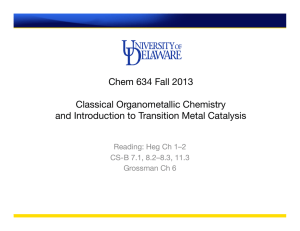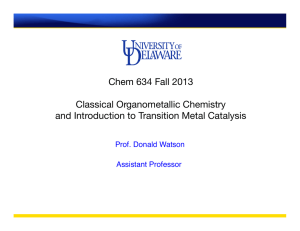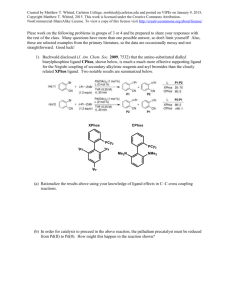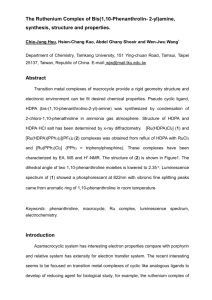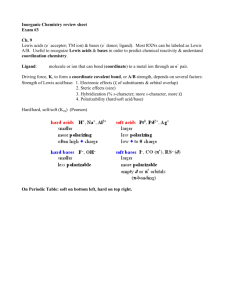Document 10529052
advertisement
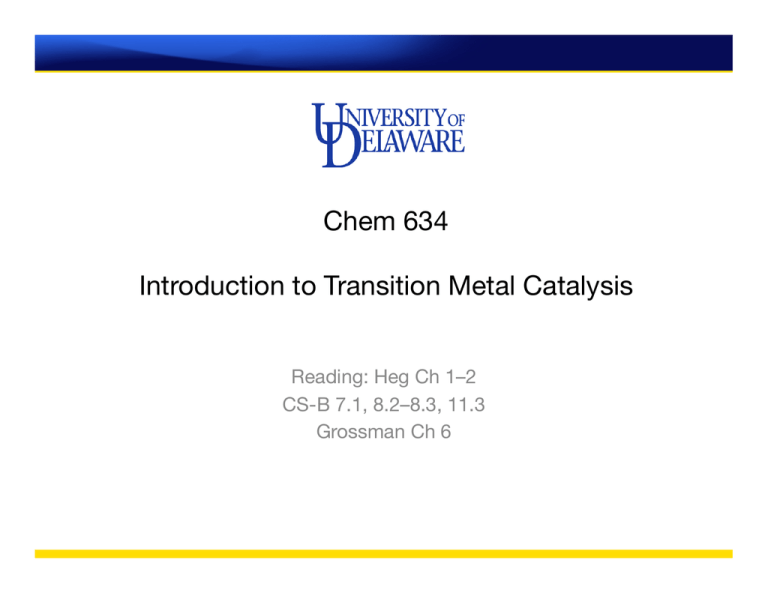
Chem 634 Introduction to Transition Metal Catalysis Reading: Heg Ch 1–2 CS-B 7.1, 8.2–8.3, 11.3 Grossman Ch 6 Announcements • Problem Set 1 due Thurs, 9/24 at beginning of class • Office Hour: Wed, 10:30-12, 220 BRL Announcements Organometallic Complexes 2– PPh3 Pd PPh3 PPh PPh3 3 Ph2 H2 P Cl N Ru P Cl N Ph2 H2 M st 0 1 row nd 2 row rd 3 row III 3 d Sc Y La early IV 4 d Ti Zr Hf V 5 d V Nb Ta Cl Cl Pt Cl Cl Ph3P Rh Cl PPh3 PPh3 Ph O otol2P Ph VI 6 d Cr Mo W CF3 N B Ir CF3 Ph VII 7 d Mn Tc Re dividing line VIII 8 d Fe Ru Os IX 9 d Co Rh Ir X 10 d Ni Pd Pt late 4 XI d s Cu Ag Au 10 1 XII 10 2 d s Zn Cd Hg How Many Valence Electrons? Consider CH4… Recall the Octet Rule 2p x 3 E LCAO's of 4 H 1s orbitals Bonding orbitals filled... stable configuration. 2s C CH4 4xH How Many Valence Electrons? Transition metals have 5 d orbitals (plus s & 3 p’s)! x M–L antibonding orbitals (n+1)p x 3 (n+1)s E nd x 5 (9–x) nonbonding orbitals Bonding and nonbonding orbitals filled... stable configuration. x M–L bonding orbitals M MLx Lx Determining Electron Count of TM Complex Ionic Method: All ligands are dissociated with their electrons. L-type ligands = neutral, 2 e- donor X-type ligands = anionic 2 e- donor n X X L M n+y L L M X X mnemonic: X L M X X L L M+ L X– Electron counting is a formalism. L where y = number of x-type ligands Example of Ionic Method Electron Counting H– O C H OC OC Fe H CO O C Fe2+ CO C O 4 X CO 2 X H– Fe(2+) (d6) 4 X 2e2 X 2e- C O H– 8e4e6e- ________________________________________ 18e- Note: Both Ionic and Neutral Methods give the same electron count, but differ in how they treat the metal center. Charged Complexes 2– 2K+ Cl Cl Cl Pd Cl 4 X ClPd(2+) (d8) 4 X 2e- 8e8e- ________________________________________ 16e- Oxidation State • Formalism to account for “oxidation state” of metal center. • This is only a formalism, in reality electrons (and thus charge) are shared over both the ligand and metal. • Nonetheless, oxidation state guides understanding of metal reactivity. • Using ionic method of electron counting arrives directly at metal oxidation state. • Example: H OC OC Fe H CO CO 4 X CO 2 X H– Fe(2+) (d6) 4 X 2e2 X 2e- 8e4e6e- ________________________________________ Oxidation State = Fe(II) 18e- Examples of X-type Ligands Ligand Disconnection Complex ligand charge ligand e- hydride M H M+ + H -1 2 halide M Cl M+ + Cl -1 2 alkyl M CR3 M+ + CR3 -1 2 aryl (σ bound) M M+ + -1 2 -1 2 M+ + acetylide M silane M SiR3 M+ + SiR3 -1 2 amido M NR2 M+ + NR2 -1 2 alkoxide M OR M+ + OR -1 2 R R Examples of X-type Ligands (More Complex) Ligand Disconnection Complex O acetate (η1) acetate (η3) allyl (η1) allyl (η3) cyclopentadienyl (Cp) M O M M M ligand e- O Me O M ligand charge Me M+ + -1 2 -1 4 M+ + -1 2 M+ + -1 4 -1 6 M+ + O Me O O Me O M+ + • 𝜼 (eta) denotes “hapticity” = how many atoms of ligand are bond to metal from single donor site. Examples of 2e– Donor “L”-type Ligands ligand charge ligand e- PPh3 0 2 M+ NEt3 0 2 M+ N CR 0 2 0 2 0 2 0 2 0 2 0 2 Ligand Complex Disconnection phopshine M PPh3 M+ amine M NEt3 nitrile M N CR H sigma bond (H–H) sigma bond (C–H) H M M+ H H H H M M+ CR3 alkene CR3 M+ M carbonyl M C ether M OR2 O M+ C M+ OR2 O “L”-type Ligands Donating More than 2e– Ligand Disconnection Complex diene M ligand charge ligand e- M+ 0 4 arene (η6) M M+ 0 6 arene (η2) M M+ 0 2 0 4 Ph Ph Ph P bisphosphine (κ2) Ph P M+ M P Ph Ph Ph Ph R R R R N diamine (κ2) 2 X 2e– L-type ligands P N M+ M P R R 4 2 X 2e– L-type ligands N R 0 R • 𝜅 (kappa) denotes “denticity” = how many binding sites of a polydentate ligand are bound . X2 Ligands Ligand Complex Disconnection 2+ CR2 ligand charge ligand e- -2 4 triplet carbenes (alkylidines) M CR2 M2+ oxo M O M2+ + O -2 4 imido (bent) M N M2+ 2+ NR -2 4 2- R NHC-Ligands Ligand Disconnection Complex R N N-heterocyclic carbenes ligand charge R N M 0 M+ N R N R Sigma Bond Pi-Backbond R M N C N R M C N N ligand e- 2 18 Electron “Rule” Many, but not all, stable, isolatable TM complexes are 18e– complexes. PPh3 Ph3P Pd PPh3 PPh3 Pd = group 10 10e- + 8e- = 18e- Ph2 Cl P Ru P Ph2 Cl H2 N N H2 Ru = group 8 +2 = d6 6+12 = 18 NOTE: 18e– “rule” is more of a suggestion. Many of the most interesting, i.e. reactive, complexes do not follow this “rule”. Basic Organometallic Mechanisms • To understand transition metal catalysis, we need to understand something about the mechanisms by which the catalysts operate. • Many TM catalyzed reactions proceed via a series of elementary steps. Dissociative Ligand Substitution L L L L M L L L -L L M L L L' L common with: • coordinately saturated • 18e- complexes L L L M L L' L Associative Ligand Substitution L' L L M L' L L L L M L L L L equatorial ligand w/ strongest pi-interactions common with: • 16 e- complexes • requires open coordination site L L L' Y* M L Y* M L' L L trans effect M L L' Oxidative Addition [Mn] R X [Mn+2] R X • formal oxidation state of metal center increases by two • favored by electron-rich metal centers Example: Ph Ph3P 0 Pd Ph3P I Ph Ph3P II Pd Ph3P I Reductive Elimination [Mn] • • • • R [Mn-2] + R R R formal oxidation state of metal center decreases by two promoted by electron poor metal centers large ligands accelerate process microscopic reverse of oxidative addition Example: Ph N NiII N N Ni0 + N O Ph N N O Transmetallation [Mn] R M' R' X [Mn] R R' + M' X • Exchange of ligands between different metal centers • No change in oxidation state at metals • Exact mechanisms are complex, some are still unknown. Example: Ph Bu3Sn Ph3P II Pd Ph3P I Ph Ph Ph3P + Bu3SnI PdII Ph3P Ph Migratory Insertion [Mn] R [Mn] X R X • Ligand inserts into adjacent metal-ligand bond • No net change of oxidation state at the metal Examples: PPh3 OC RhI PPh3 CO OC PPh3 PPh3 R Ar Ph3P PdII PPh3 O RhI + R + Ph3P PdII PPh3 Ar β-Elimination R [Mn] [Mn] R • • • • Microscopic reverse of migratory insertion No net change of oxidation state at the metal Most often observed as β-hydride elimination from alkyl ligand Requires open coordination site on the metal center Example: + PPh3 Ph3P note open coordination site Ar PdII H PPh3 Ph3P PdII H + β-Elimination Note: most of the time, β-hydride elimination is superfacial. This is because the mechanism is inner-sphere, involving formation of a metal-hydride bond. H1 [Pd] Ph Ph H3 note open coordination site H3 + PPh3 Ph3P H2 H2 Ar PdII H PPh3 Ph3P PdII H + α-Elimination R R' R [Mn] [Mn] H + HR' Via: R R' [Mn] H or: R [Mn] R' ‡ H not common in organic synthesis Oxidative Coupling/Cyclization ‡ [Mn] [Mn] [Mn+2] σ−Bond Metathesis [M] R' + R R'' R' R'' [M] R Via: [M] R R' R'' ‡ [M] R R' R'' Common mechanism of C-H bond activation. π−Bond Metathesis X Y [M] X + R Y [M] R via: [M] X R Y [2+2] [M] R X Y [retro 2+2] Common in alkene metathesis. [M] R X Y
